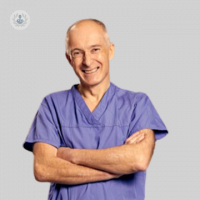Laryngeal papillomatosis - what is it and how is this condition treated?
Written in association with:One of the most difficult things to manage for doctors looking at the larynx is infection by the human papillomavirus (HPV). Fortunately, this is a very rare condition, but there are perhaps 800 patients with this condition in the United Kingdom presently. It is a chronic condition with no cure available at this time. The adult form can affect people at any age from the 20s up until the 50s, but there is a suggestion that it burns out over time, as it is rare to see this condition present in a patient after that time.
The laryngeal form of HPV is called recurrent respiratory papillomatosis (RRP) and results in benign growths on the air passages leading from the nose and mouth into the lungs. By far the commonest site is the larynx (the voice box). This is known as laryngeal papillomatosis. Once removed from the larynx, these growths have a strong tendency to return, and hence this is why it is a chronic condition. Professor Martin Anthony Birchall is a world-renowned ENT surgeon and laryngeal papillomatosis is one of his areas of expertise, as well as an area of his ongoing research.
What are the main symptoms of RRP?
Due to the friction on the vocal cords caused by the papillomas, common symptoms can include hoarseness, coughing and sometimes breathing problems. As the symptoms are similar to those of asthma and bronchitis, this can sometimes be misdiagnosed.
How are papillomas on the larynx treated?
When treating the warts on the larynx that result from this infection, it is very important for the surgeon to take great care to preserve as much as possible of the thin membranes over the vocal cords that are responsible for normal speech. Therefore, I prefer using a very low powered laser to simply close down the blood vessels that supply the warts, or alternatively, use very fine micro-instruments to remove them one by one where they affect the vocal cords themselves. This is all done as a day-case under a relatively short general anaesthetic and typically patients with this condition have to have such procedures at least once a year.

In this image, taken in the day-case operating theatre, I am using the latest flexible carbon dioxide laser via a flexible endoscope to treat the feeding vessels to a difficult-to-reach laryngeal papilloma in a patient with RRP.
What does the future hold for treating this condition?
However, there is some hope around the corner with a better understanding of the immunology of this condition and trial of newer agents designed to reduce the blood vessels or to treat the changes induced by the papillomavirus directly. I have been kindly invited to join the Airway Intervention Registry (AIR) steering group based in Newcastle which is seeking to collect data on all the patients with recurrent respiratory papillomatosis (RRP) in the UK. Hence, I am trying to spread the word both directly and through the British Laryngological Association (BLA) that all ENT surgeons who see patients with this condition should register patients with AIR.
Happily, with other pressure groups, the BLA and patient groups such as the National Association of Laryngectomee Clubs (NALC) have successfully lobbied government to immunise boys as well as girls of school age against HPV, and therefore we hope that the condition will gradually die out altogether over the coming decades. This is certainly the trend we have seen in Australia where immunisation started before the UK.
I am passionate about using the latest and the safest techniques for managing patients with laryngeal disease and I am pleased to see that these developments, plus ongoing trials of exciting new medical therapies, do give us glimmers of hope for people troubled by this recalcitrant disease.
If you need to see an ENT surgeon, make an appointment with an expert.



